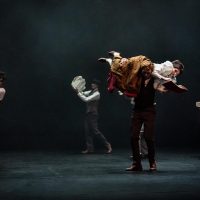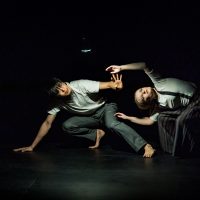Marić at the Lake casts a shadow on Einstein
Did you know that “Einstein” or “ein stein” means “one stone” in german? “Ein” is “one,” and “stein” is “stone.” Mileva Marić (say, Mil-ehva Marrritch), is a slavic name, with a less obvious meaning. Some search results show that “Mileva” means “favourite,” others show that “mileva,” or “милева” is bulgarian for “mile,” and “Marić” can be broken down into many things. “Mari,” in french, refers to “husband,” but in romanian, “mari” means “big.” “Marić” could also just so happen to be a common name in Serbia, like “Smith” or “Boucher,” which allude to the profession of the family’s ancestors. One particularly interesting website (kabalarians.com), states, rather negatively, that “Maric” is the name of an ambitious, work-oriented, introverted person who is logical, motivated, aggressive and uncompromising.
Mileva Marić (1875-1948), Albert Einstein’s first wife, seems to embody all of the above, or at least, the way Concordia’s theatre department portrayed her did. With the spotlight shining ever so brightly on the physicist who defined the theory of relativity, one of two pillars of modern-day physics, Marić fell in his rather large shadow. But, as they say, behind every man is a great woman一only popular culture can’t seem to define how great a woman Marić was.
There have been continuous, inconclusive debates about her potential contributions to Einstein’s work, which serves as the foundation for Marić at the Lake. The play, a collaboration across programmes in the department of theatre, is a reaction to the 1976 opera, Einstein on the Beach. Composed by Philip Glass and directed by Robert Wilson, this five-hour opera was epic and magical, though it focused entirely on Einstein’s genius. Concordia’s rendition to this painstakingly long number was equally brilliant, speculative, much more inclusive, and only 75 minutes long.
In director Cathia Pagotto’s notes, she writes, “despite Marić’s hardships, we choose to believe she may have observed the patterns in her life with poetic objectivity, that she would have seen the absurdity, tragedy, and poignancy of her surroundings, and embraced the beauty of a life that appeared to have fallen on the wrong side of relativity.” Pagotto, the cast, production and design team, did just that.
With a cast playing rotating roles, everyone got a chance to portray Einstein and Marić in their own way. The devised play was created through collaboration, improvisation and trial and error. Marić at the Lake brought together design, acting and performance creation students from across the department of theatre.
Design and performance creation come together in the fall for a six-credit class where they began to workshop ideas for a show that will take place in March or April. Once the script and storyboard are lined up, actors apply for a three-credit course that will select them for one performance or another. What made Marić at the Lake a particularly unique experience was the visual script. Ideas had to be represented in movement according to the actors’ own strengths, talents and abilities.
The actors, part of the theatre departments Acting for the Theatre and Performance Creation programmes, had the rare opportunity to perform non-verbal roles. Their storyline was carried instead through movement, similar to a dance or silent film. Some students in the Design for the Theatre program came together in a performance creation class to layout the visuals for the play, ensuring every element was striking enough to speak for itself.
Þórhildur Sunna Jóhannsdóttir designed the play’s many costumes, ranging from traditional Serbian-inspired garb, suits, dresses and giant bubbles. Not only did they situate the time and mood of the piece, but they added just an extra bit of humour, speaking volumes to a clouded story.
Jóhannsdóttir’s Marić claims the stage as her own, diminishing Einstein. This is Marić’s story.
The set design, by Anna Toneguzzi, was kept rather simple, with a slavic-inspired rug, symbolic of Marić’s ties to her family and culture, and clouds up in the sky, for Einstein’s air of importance.
Einstein and Marić work together, and at opposite ends of the room, furiously scribbling away. The two physicists met at a university in Zurich, and took to each other immediately. During school holidays they would exchange letters, some of which are the only proof of Marić’s role in Einstein’s discoveries.
From Scientific American magazine,
In August 1899, Albert wrote to Mileva: “When I read Helmholtz for the first time, it seemed so odd that you were not at my side and today, this is not getting better. I find the work we do together very good, healing and also easier.” Then on 2 October 1899, he wrote from Milan: “… the climate here does not suit me at all, and while I miss work, I find myself filled with dark thoughts – in other words, I miss having you nearby to kindly keep me in check and prevent me from meandering”.
Whether the piles of books on Marić’s head were proof of her own commitment to mathematics or just a burden she was carrying remains unclear. Considering these debates, Pagotto gave justice to Marić’s story, telling it beautifully.
Photos courtesy of Antoine Saito.







